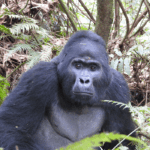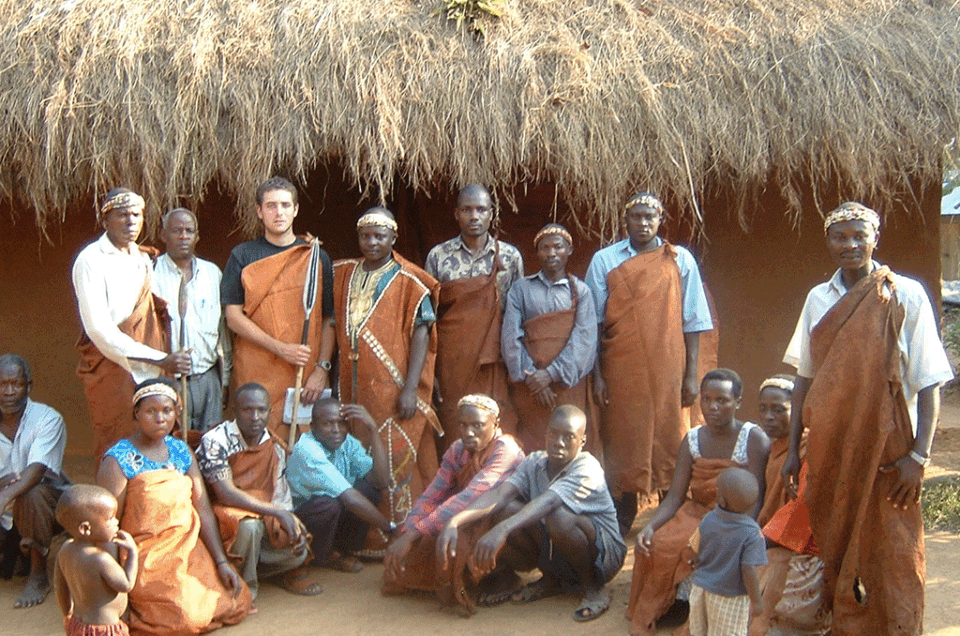Cultural experience you can’t miss on your Safari in Uganda, boasts a rich tapestry of both diverse cultures and wildlife. The country is home to over 50 ethnic groups, each with unique traditions, customs, and languages. Uganda is also renowned for its incredible biodiversity, particularly its primates, including the iconic mountain gorillas and chimpanzees, and a wide array of other mammals and over 1,000 bird species.
Home to over 56 different ethnic groups, each with their own distinct language, customs, and traditions, Uganda presents a unique tapestry of cultural heritage. Despite this diversity, there is a strong sense of national identity that unites Ugandans.
Ugandan traditions include folk music, dances, foods, clothing, and building styles, among others. In Northern Uganda, particularly the Lango sub-region, a healing ritual called child-cleansing ceremony is conducted to restore the lost manhood of a child.
Ndeere Cultural Centre the Cultural Hub
Ndeere Cultural Centre.. Uganda is home to around 56 tribes from several ethnic grouping of which includes the Bantu, Luo, Nilotics, Nilo Hamites. Each Ugandan tribe has a distinct culture that has been passed down from generation to generation in the form of food, song, attire, dance and folklore among others.
Uganda culture is comprised of a broad spectrum of ethnic groups. The Bantu speaking people, who rule much of East, Central and Southern have Lake Kyoga as their Northern frontier. They include the Buganda and numerous others tribes of Uganda.
The Baganda are Uganda’s most populous ethnic group of people. They lie in central region of the Uganda and are the biggest tribe in the country; they are speaking Luganda as their first language.
Ndeere cultural centre is one of most synonymous with traditional Uganda dance, songs and food from all around the nation. Every Wednesday, Friday and Sunday evening in a week, their over 400 seaters at Ndeere amphitheatre is packed. The stage is filled with talented traditional dancers dressed in traditional dance attire, moving, shuffling, gyrating, gesturing and stamping to the lovely tunes of the vocalists, drummers and instrument players in the background.
The Kasubi Tombs the Burial Site for Buganda Kings
The site is a major spiritual centre for the Baganda and is the most active religious place in the kingdom. The structures and the traditional practices that are associated with the site are one of the exceptional representations of the African culture that depict a continuity of a living tradition
The Tombs of Buganda Kings at Kasubi constitute a site embracing almost 30 ha of hillside within Kampala district. Most of the site is agricultural, farmed by traditional methods. At its core on the hilltop is the former palace of the Kabakas of Buganda, built in 1882 and converted into the royal burial ground in 1884. Four royal tombs now lie within the Muzibu Azaala Mpanga, the main building, which is circular and surmounted by a dome. It is a major example of an architectural achievement in organic materials, principally wood, thatch, reed, wattle and daub. The site’s main significance lies, however, in its intangible values of belief, spirituality, continuity and identity.
The Tombs of Buganda Kings constitute a site embracing 26.8 hectares of Kasubi hillside within Kampala City. The site is the major spiritual centre for the Baganda where traditional and cultural practices have been preserved. The Kasubi Tombs are the most active religious place in the kingdom, where rituals are frequently performed. Its place as the burial ground for the previous four kings (Kabakas) qualifies it as a religious centre for the royal famil y, a place where the Kabaka and his representatives carry out important rituals related to Buganda culture. The site represents a place where communication links with the spiritual world are maintained.
Its spatial organization, starting from the border of the site marked with the traditional bark cloth trees, leading through the gatehouse, the main courtyard, and culminating in the large thatched building, housing the tombs of the four Kabakas, represents the best existing example of a Baganda palace/burial site.
At its core on the hilltop is the main tomb building, locally referred to as the “Muzibu-Azaala-Mpanga” which is a masterpiece of this ensemble. A tomb building has been in existence since the 13th century. The latest building was the former palace of the Kabakas of Baganda, built in 1882 and converted into the royal burial ground in 1884. Four royal tombs now lie within the Muzibu-Azaala-Mpanga.
The main tomb building, which is circular and surmounted by a dome, is a major example of an architectural achievement that was raised with use of vegetal materials comprised of wooden poles, spear grass, reeds and wattle. Its unusual scale and outstanding details bear witness to the creative genius of the Baganda and as a masterpiece of form and craftsmanship; it is an exceptional surviving example of an architectural style developed by the powerful Buganda Kingdom since the 13th Century.
Although the recent fire tragedy, that destroyed the main tomb building, means that one key attribute is now missing, the cultural traditions associated with building in poles, spear grass, reeds and wattle are still vibrant and will allow the recreation of this tomb building.
The other traditional structures are still in place and the key attributes related to traditional ceremonial and religious practices and land tenure and land use practices are still being maintained.
The Karamojong’s Tribe
The Karamojong’s are a cluster of related ethnic groups residing in the Karamoja region of northeastern Uganda. They are known for their semi-nomadic pastoral lifestyle, centered on cattle herding, and their rich cultural traditions. Key groups within the Karamojong cluster include the Matheniko, Bokora, Nyakai, and Pemba, each with their own distinct identity.
The Karamojong or Karamojong are a Nilotics ethnic group. They are agro-pastoral herders living mainly in the north-east of Uganda. Their language is also known as ngaKarimojong and is part of the Nilotics language family. Their population is estimated at 475,000 people.
Currently, the Karamoja sub-region hosts 13 different tribes that really mans are all entered during the Nilotics migration and the typical people called the Karamojong hey are only four including the mechanical of Moroto, the Bokora of Napak, the Nyakai of eastern side of Abim and the Piambe
Many challenges exist also in terms of access to quality education, infrastructure, and other crucial necessities. Additionally, Karamoja is a region where inter-ethnic conflict has historically generated insecurity, instability, and fragility.
Batwa Tribes
The Batwa, also known as the Twa or Pygmies, are an indigenous group in Uganda, historically known as hunter-gatherers and forest keepers. They are one of the oldest populations in the Great Lakes region. Originally inhabiting the rainforests of southwestern Uganda, they were displaced when Bwindi and Mgahinga forests were designated as national parks. Today, they are among the poorest and most marginalized communities in Uganda.
The Batwa were traditionally forest-dwelling hunter-gatherers, living in harmony with the environment and its wildlife, including gorillas. They are skilled in hunting, gathering, and crafting tools from the forest.
In the 1990s, the Batwa were evicted from their ancestral lands in Bwindi and Mgahinga to make way for national parks and conservation efforts. This forced displacement has had a significant negative impact on their way of life and livelihoods.
Today, the Batwa face poverty, limited access to healthcare and education, and are largely dependent on others for their survival. Some have found work as trail guides for tourists, while others engage in low-paid agricultural work or craft-making.
The Batwa have a rich cultural heritage, including traditional songs, dances, and knowledge of medicinal plants. They are also recognized for their unique skills in forest-related activities like hunting, gathering, and shelter construction.
Organizations like the Mgahinga and Bwindi Impenetrable Forest Conservation Trust (MBIFCT) are working to support the Batwa, providing them with access to resources and helping them adapt to their new circumstances.
Amabeere ga Nyinamwiru
Amabeere ga Nyina Mwiru, meaning “breasts of Nyinamwiru,” is a unique cultural and natural site located in western Uganda, near Fort Portal. It’s known for its caves formed by stalactites and stalagmites, which are said to resemble the breasts of Nyinamwiru, a legendary figure from the Toro Kingdom’s history. The site is also known for its waterfalls, crater lakes, and green hills, offering a blend of cultural significance and natural beauty.
The caves are situated about 10 kilometers (6.2 miles) from Fort Portal city. The “breasts” are actually stalactites and stalagmites formed by the precipitation of limestone from dripping water.
According to local legend, Nyinamwiru was the daughter of King Bukuku, and the caves are named after her because of her breasts being cut off and placed there, according to a prophecy.
The site is a protected cultural site, holding significant cultural and spiritual importance for the local community. Visitors can explore the caves, enjoy nearby waterfalls, hike to crater lakes (like Lake Kigere, Lake Nyabikere, and Lake Saka), and learn about the local folklore and traditions.
The area also features green hills, including the Nyakasura hills, and offers opportunities for hiking and viewing the surrounding landscape.
The Bugungu Tribe
The Bagungu (also known as Gungu) are an indigenous Bantu ethnic group in Uganda, primarily residing in the Buliisa, Hoima, and Masindi districts, particularly on the northeastern shores of Lake Albert. They are traditionally fishermen and farmers, with a distinct dialect of the Runyoro language called Lugungu. The Bagungu are known for their traditional practices, including sustainable land management and conservation efforts, which are currently facing challenges due to oil exploration in the region.
The Gungu or (Bagungu) are a Bantu ethnic group native to Uganda. They live on the northeastern shores of Lake Albert along the Rift Valley. They speak a distinct dialect of the Runyoro language called Lugungu. They are traditionally fishermen, pastoralists, and subsistence farmers.
The Bagungu live in the Great Rift Valley, near Lake Albert, in western Uganda. They are a mixture of Bantu and Nilotic groups, with origins tracing back to intermarriages between Bantu from central and southern Uganda and the Paluo (Chope) Nilotes from Northern Uganda, according to 101 Last Tribes.
Bagungu are traditionally fishermen and farmers, with cassava being a staple crop. They have traditional methods for conserving their land and resources, including restricting access to sacred areas and designating wildlife sanctuary
The Bagungu belong to the Bugungu region under the Bunyoro Kingdom, but there are also movements for them to establish their own cultural institution.
The Bagungu are a mixture of Bantu and Nilotics ethnic groups. They originated from an intermarriage between Bantu from central, and southern Uganda, and the Palou (Chope) nilotes from Northern Uganda. The Bagungu belong to Bugungu region under Bunyoro Kingdom led by an Omukama
Namugongo Martyrs Shrine
The Uganda martyrs shrine / Namugongo Shrine was constructed in the commemoration of the baganda men that sacrificed their lives for the sake of the Christian faith in Uganda. The Uganda martyrs were killed quite a long time ago, about decades ago.
The Uganda Martyrs, including those martyred at Namugongo, were converts to Christianity who were executed in Buganda between 1885 and 1887. These individuals, predominantly from the Catholic and Anglican communities, were killed for their faith under the orders of Kabaka Mwanga, the King of Buganda, who opposed the introduction of Christianity. The persecution was rooted in the King’s opposition to the growing influence of missionaries and the conversion of Buganda’s elite to Christianity.
Located near Kampala, the shrine marks the place where many martyrs were burned alive. It serves as a major pilgrimage destination, drawing thousands of Catholic and Anglican faithful annually on June 3rd to commemorate their courage and sacrifice.
The most prominent shrine is Namugongo, which is located where St. Charles Lwanga and his companions were burned. The Ugandan Christian tradition of honoring martyrs is important because, in doing so, Ugandan Christians honor their pre-Christian heritage of spirituality and ancestry.
The name “Namugongo” was got from the word Omugongo, a Luganda word for the “back” of the body. Some explains that “during the journey or movement to the execution site, the prisoners went through a lot of torture, which also included dragging them on their backs (Omugongo) to move on, some asked how do they reach here replied that they reach by back that is where the name came from came with back translate to ( Namugongo).








